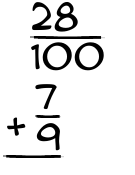What is 28/100 + 7/9?

|
Here's how we add
|
|||||||||||||||||||||||||
Step 1We can't add two fractions with different denominators (the bottom number). So you need to get a common denominator - both bottom numbers need to match. To do this, you'll multiply the denominators times each other... but the numerators have to change, too. They get multiplied by the other term's denominator. So we multiply 28 by 9, and get 252, then we multiply 100 by 9 and get 900. Do the same for the second term. We multiply 7 by 100, and get 700, then multiply 100 by 9 and get 900. So now our fractions look like this:
|
|||||||||||||||||||||||||
Step 2Since our denominators match, we can add the numerators. 252 + 700 = 952 So the answer is:
|
|||||||||||||||||||||||||
Step 3Last of all, we need to simplify the fraction, if possible. Can it be reduced to a simpler fraction? To find out, we try dividing it by 2... Are both the numerator and the denominator evenly divisible by 2? Yes! So we reduce it:
Let's try dividing by that again... Are both the numerator and the denominator evenly divisible by 2? Yes! So we reduce it:
Let's try dividing by that again... Nope! So now we try the next greatest prime number, 3... Nope! So now we try the next greatest prime number, 5... Nope! So now we try the next greatest prime number, 7... Nope! So now we try the next greatest prime number, 11... Nope! So now we try the next greatest prime number, 13... Nope! So now we try the next greatest prime number, 17... Nope! So now we try the next greatest prime number, 19... Nope! So now we try the next greatest prime number, 23... Nope! So now we try the next greatest prime number, 29... Nope! So now we try the next greatest prime number, 31... Nope! So now we try the next greatest prime number, 37... Nope! So now we try the next greatest prime number, 41... Nope! So now we try the next greatest prime number, 43... Nope! So now we try the next greatest prime number, 47... Nope! So now we try the next greatest prime number, 53... Nope! So now we try the next greatest prime number, 59... Nope! So now we try the next greatest prime number, 61... Nope! So now we try the next greatest prime number, 67... Nope! So now we try the next greatest prime number, 71... Nope! So now we try the next greatest prime number, 73... Nope! So now we try the next greatest prime number, 79... Nope! So now we try the next greatest prime number, 83... Nope! So now we try the next greatest prime number, 89... Nope! So now we try the next greatest prime number, 97... Nope! So now we try the next greatest prime number, 101... Nope! So now we try the next greatest prime number, 103... Nope! So now we try the next greatest prime number, 107... Nope! So now we try the next greatest prime number, 109... Nope! So now we try the next greatest prime number, 113... Nope! So now we try the next greatest prime number, 127... Nope! So now we try the next greatest prime number, 131... Nope! So now we try the next greatest prime number, 137... Nope! So now we try the next greatest prime number, 139... Nope! So now we try the next greatest prime number, 149... Nope! So now we try the next greatest prime number, 151... Nope! So now we try the next greatest prime number, 157... Nope! So now we try the next greatest prime number, 163... Nope! So now we try the next greatest prime number, 167... Nope! So now we try the next greatest prime number, 173... Nope! So now we try the next greatest prime number, 179... Nope! So now we try the next greatest prime number, 181... Nope! So now we try the next greatest prime number, 191... Nope! So now we try the next greatest prime number, 193... Nope! So now we try the next greatest prime number, 197... Nope! So now we try the next greatest prime number, 199... Nope! So now we try the next greatest prime number, 211... Nope! So now we try the next greatest prime number, 223... Nope! So now we try the next greatest prime number, 227... No good. 227 is larger than 225. So we're done reducing. There you have it! Here's the final answer to 28/100 + 7/9
|